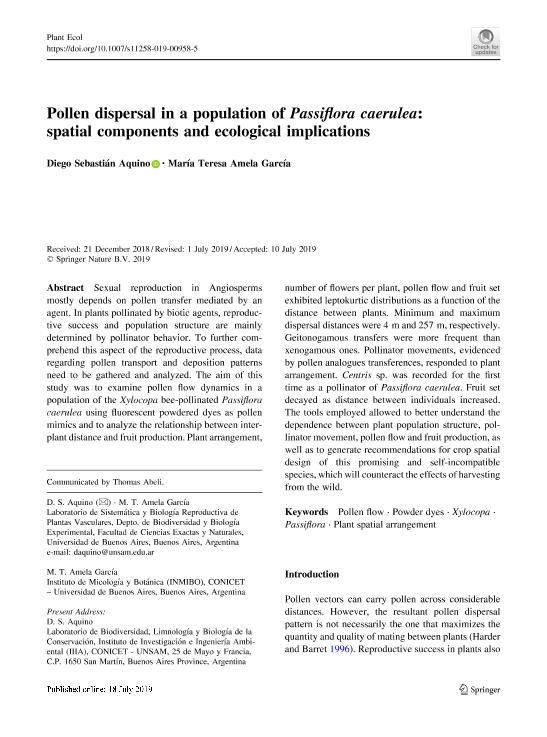Artículo
Pollen dispersal in a population of Passiflora caerulea: spatial components and ecological implications
Fecha de publicación:
09/2019
Editorial:
Springer
Revista:
Plant Ecology
ISSN:
1385-0237
Idioma:
Inglés
Tipo de recurso:
Artículo publicado
Clasificación temática:
Resumen
Sexual reproduction in Angiosperms mostly depends on pollen transfer mediated by an agent. In plants pollinated by biotic agents, reproductive success and population structure are mainly determined by pollinator behavior. To further comprehend this aspect of the reproductive process, data regarding pollen transport and deposition patterns need to be gathered and analyzed. The aim of this study was to examine pollen flow dynamics in a population of the Xylocopa bee-pollinated Passiflora caerulea using fluorescent powdered dyes as pollen mimics and to analyze the relationship between inter-plant distance and fruit production. Plant arrangement, number of flowers per plant, pollen flow and fruit set exhibited leptokurtic distributions as a function of the distance between plants. Minimum and maximum dispersal distances were 4 m and 257 m, respectively. Geitonogamous transfers were more frequent than xenogamous ones. Pollinator movements, evidenced by pollen analogues transferences, responded to plant arrangement. Centris sp. was recorded for the first time as a pollinator of Passiflora caerulea. Fruit set decayed as distance between individuals increased. The tools employed allowed to better understand the dependence between plant population structure, pollinator movement, pollen flow and fruit production, as well as to generate recommendations for crop spatial design of this promising and self-incompatible species, which will counteract the effects of harvesting from the wild.
Palabras clave:
POLLEN FLOW
,
POWDER DYES
,
PASSIFLORA
,
XYLOCOPA
Archivos asociados
Licencia
Identificadores
Colecciones
Articulos (IIIA)
Articulos de INSTITUTO DE INVESTIGACION E INGENIERIA AMBIENTAL
Articulos de INSTITUTO DE INVESTIGACION E INGENIERIA AMBIENTAL
Articulos(INMIBO (EX - PROPLAME))
Articulos de INSTITUTO DE MICOLOGIA Y BOTANICA
Articulos de INSTITUTO DE MICOLOGIA Y BOTANICA
Citación
Aquino, Diego Sebastián; Amela Garcia, Maria Teresa; Pollen dispersal in a population of Passiflora caerulea: spatial components and ecological implications; Springer; Plant Ecology; 220; 9; 9-2019; 845-860
Compartir
Altmétricas




